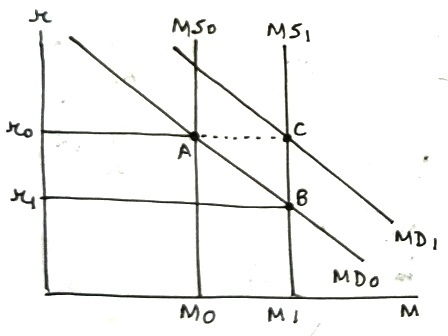Question
In: Economics
Suppose a global recession is underway. Answer the following questions using the money market. (a) What...
Suppose a global recession is underway. Answer the following questions using the money market.
(a) What action will the Fed likely take? How will their interest rate target change? What action will they take to achieve their target?
(b) Using a graph of the money market, what happens on impact in response to that change in policy?
(c) How does the money market transition to the new equilibrium?
Solutions
Expert Solution
(a)
During recession, Fed will increase aggregate demand by increasing money supply. This is done by open market purchase of securities and/or by decreasing discount rate and/or by decreasing reserve ratio.
Increase in money supply will decrease interest rate.
(b)
In following graph, MD0 and MS0 are initial money demand and supply curves, intersecting at point A with initial interest rate r0 and quantity of money M0. When money supply rises, MS0 shifts right to MS1, intersecting MD0 at point B with lower interest rate r1 and higher quantity of money M1.

(c)
In long run, higher interest rate will increase the demand for bonds and decrease the demand for money, shifting money demand curve to left until it intersects new money supply curve at original interest rate.
In above graph, MD0 will shift left to MD1, intersecting MS0 at point C with initial interest rate r0 and quantity of money M1.
Related Solutions
Use the money market and FX diagrams to answer the following questions.
Use the money market equilibrium and Foreign Exchange (Forex) market equilibrium to answer the following questions....
Use the money market equilibrium and Foreign Exchange (Forex) market equilibrium to answer the following questions....
Use the money market equilibrium and Foreign Exchange (Forex) market equilibrium to answer the following questions....
Use the money market equilibrium and Foreign Exchange (Forex) market equilibrium to answer the following questions....
Use the money market equilibrium and Foreign Exchange (Forex) market equilibrium to answer the following questions....
Use the money market equilibrium and Foreign Exchange (Forex) market equilibrium to answer the following questions....
Use the money market and FX diagrams to answer the following questions. This question considers the...
Use the foreign exchange and money market diagrams to answer the following questions about the relationship...
Use the money market and FX diagrams to answer the following questions about the relationship between...
- The general ledger of the Karlin Company, a consulting company, at January 1, 2021, contained the...
- In Linux Professional: PE15 (CH) 1 – why is the max RAM for a 32-bit OS...
- Use the following words to script that mirrors a conversation that you might have with a...
- I need C++ code Given the complete main() function, partial playlist class header playlist.h, and playlist.cpp,...
- "Elizabeth Egbert owns a galvanizing plant. Customers bring in their fabricated steel products (like light poles,...
- Write a general-purpose program with loop and indexed addressing that adds 12h to 0th, 3rd ,...
- Exercise 1: Write a C program that does the following tasks: a. Declare a structure called...
 Rahul Sunny answered 1 month ago
Rahul Sunny answered 1 month ago